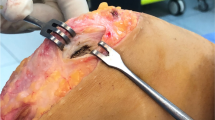Abstract
Purpose
This study aimed at investigating the influence of an increased femoral anteversion angle on clinical outcomes after medial patellofemoral ligament reconstruction and combined tibial tubercle osteotomy for the treatment of recurrent patellar instability. It was hypothesized that an increased femoral anteversion is associated with inferior clinical outcomes.
Methods
From 2014 to 2016, a total of 144 consecutive patients with recurrent patellar instability were treated with medial patellofemoral ligament reconstruction and combined tibial tubercle osteotomy. The femoral anteversion angle was measured using three-dimensional computed tomography scans. Patients were allocated into group A (femoral anteversion < 20°), group B (femoral anteversion 20°–30°) and group C (femoral anteversion > 30°) based on the value of the femoral anteversion angle. Routine radiography and CT examinations were performed to evaluate the patellar height, trochlear dysplasia, genu valgum, and tibial tuberosity–trochlear groove (TT–TG) distance. The patellar lateral shift distance assessed with stress radiography was used pre- and postoperatively to quantify medial patellofemoral ligament residual laxity under anaesthesia. Patient-reported outcomes (Kujala, IKDC, and Lysholm scores) and patellar maltracking (“J-sign”) were evaluated pre- and postoperatively. Finally, subgroup analysis was performed to investigate the influence of an increased femoral anteversion angle on the clinical and radiological outcomes.
Results
A total of 66 patients (70 knees) were included with a median follow-up time of 28 months (range 24–32). After a minimum of 2 years of follow-up, all patient-reported outcomes (Kujala, Lysholm, and IKDC scores) improved significantly, and subgroup analysis showed that group C had significantly lower Kujala scores (75 ± 8 vs. 84 ± 8, P13 = 0.003; 75 ± 8 vs. 82 ± 8, P23 = 0.030), Lysholm scores (81 ± 9 vs. 87 ± 7, P13 = 0.021) and IKDC scores (78 ± 6 vs. 85 ± 7, P13 = 0.001; 78 ± 6 vs. 84 ± 6, P23 = 0.005) than group A and group B. Twelve patients had a postoperative residual J-sign (17.1%), and significant differences were found between group C and group A regarding the rate of residual J-sign (32.1% vs. 4.8%, P13 = 0.003). Postoperatively, group C had a greater patellar lateral shift distance than group A (10 ± 4 vs. 6 ± 4 mm, P13 = 0.006) and group B (10 ± 4 vs. 6 ± 3 mm, P23 = 0.008). Additionally, patients with a residual J-sign demonstrated greater medial patellofemoral ligament laxity than patients without a residual J-sign (12 ± 4 vs. 9 ± 3 mm, P = 0.009).
Conclusion
Patients with an increased femoral anteversion angle (> 30°) had inferior postoperative clinical outcomes, including greater patellar laxity, a higher rate of residual J-sign and lower patient-reported outcomes after medial patellofemoral ligament reconstruction and combined tibial tubercle osteotomy for the treatment of recurrent patellar instability.
Level of evidence
III, retrospective cohort study.



Similar content being viewed by others
References
Allen MM, Krych AJ, Johnson NR, Mohan R, Stuart MJ, Dahm DL (2018) Combined tibial tubercle osteotomy and medial patellofemoral ligament reconstruction for recurrent lateral patellar instability in patients with multiple anatomic risk factors. Arthroscopy 34(8):2420–2426
Ateschrang A, Freude T, Grunwald L, Schaffler A, Stockle U, Schroter S (2014) Patella dislocation: an algorithm for diagnostic and treatment considering the rotation. Z Orthop Unfall 152(1):59–67
Camp CL, Stuart MJ, Krych AJ, Levy BA, Bond JR, Collins MS et al (2013) CT and MRI measurements of tibial tubercle–trochlear groove distances are not equivalent in patients with patellar instability. Am J Sports Med 41(8):1835–1840
Cooke TD, Price N, Fisher B, Hedden D (1990) The inwardly pointing knee. An unrecognized problem of external rotational malalignment. Clin Orthop Relat Res 260:56–60
Dejour D, Le Coultre B (2007) Osteotomies in patello-femoral instabilities. Sports Med Arthrosc Rev 15(1):39–46
Dejour H, Walch G, Nove-Josserand L, Guier C (1994) Factors of patellar instability: an anatomic radiographic study. Knee Surg Sports Traumatol Arthrosc 2(1):19–26
Dickschas J, Harrer J, Pfefferkorn R, Strecker W (2012) Operative treatment of patellofemoral maltracking with torsional osteotomy. Arch Orthop Trauma Surg 132(3):289–298
Dickschas J, Harrer J, Reuter B, Schwitulla J, Strecker W (2015) Torsional osteotomies of the femur. J Orthop Res 33(3):318–324
Dickschas J, Tassika A, Lutter C, Harrer J, Strecker W (2017) Torsional osteotomies of the tibia in patellofemoral dysbalance. Arch Orthop Trauma Surg 137(2):179–185
Diederichs G, Köhlitz T, Kornaropoulos E, Heller MO, Vollnberg B, Scheffler S (2013) Magnetic resonance imaging analysis of rotational alignment in patients with patellar dislocations. Am J Sports Med 41(1):51–57
Dwyer T, Martin CR, Kendra R, Sermer C, Chahal J, Ogilvie-Harris D et al (2017) Reliability and validity of the arthroscopic international cartilage repair society classification system: correlation with histological assessment of depth. Arthroscopy 33(6):1219–1224
Franciozi CE, Ambra LF, Albertoni LJB, Debieux P, Granata GSM Jr, Kubota MS et al (2019) Anteromedial tibial tubercle osteotomy improves results of medial patellofemoral ligament reconstruction for recurrent patellar instability in patients with tibial tuberosity–trochlear groove distance of 17–20 mm. Arthroscopy 35(2):566–574
Franciozi CE, Ambra LF, Albertoni LJ, Debieux P, Rezende FC, Oliveira MA et al (2017) Increased femoral anteversion influence over surgically treated recurrent patellar instability patients. Arthroscopy 33(3):633–640
Frosch KH, Schmeling A (2016) A new classification system of patellar instability and patellar maltracking. Arch Orthop Trauma Surg 136(4):485–497
Hinterwimmer S, Rosenstiel N, Lenich A, Waldt S, Imhoff AB (2012) Femoral osteotomy for patellofemoral instability. Unfallchirurg 115(5):410–416
Imhoff FB, Cotic M, Liska F, Dyrna FGE, Beitzel K, Imhoff AB et al (2019) Derotational osteotomy at the distal femur is effective to treat patients with patellar instability. Knee Surg Sports Traumatol Arthrosc 27(2):652–658
Kaiser P, Schmoelz W, Schoettle P, Zwierzina M, Heinrichs C, Attal R (2017) Increased internal femoral torsion can be regarded as a risk factor for patellar instability—a biomechanical study. Clin Biomech (Bristol, Avon) 47(4):103–109
Kaiser P, Schmoelz W, Schöttle PB, Heinrichs C, Zwierzina M, Attal R (2019) Isolated medial patellofemoral ligament reconstruction for patella instability is insufficient for higher degrees of internal femoral torsion. Knee Surg Sports Traumatol Arthrosc 27(3):758–765
Lee TQ, Anzel SH, Bennett KA, Pang D, Kim WC (1994) The influence of fixed rotational deformities of the femur on the patellofemoral contact pressures in human cadaver knees. Clin Orthop Relat Res 302:69–74
Liu JN, Brady JM, Kalbian IL, Strickland SM, Ryan CB, Nguyen JT et al (2018) Clinical outcomes after isolated medial patellofemoral ligament reconstruction for patellar instability among patients with trochlear dysplasia. Am J Sports Med 46(4):883–889
Nelitz M, Williams RS, Lippacher S, Reichel H, Dornacher D (2014) Analysis of failure and clinical outcome after unsuccessful medial patellofemoral ligament reconstruction in young patients. Int Orthop 38(11):2265–2272
Nelitz M, Dreyhaupt J, Williams SR, Dornacher D (2015) Combined supracondylar femoral derotation osteotomy and patellofemoral ligament reconstruction for recurrent patellar dislocation and severe femoral anteversion syndrome: surgical technique and clinical outcome. Int Orthop 39(12):2355–2362
Neri T, Parker DA, Beach A, Gensac C, Boyer B, Farizon F et al (2019) Medial patellofemoral ligament reconstruction with or without tibial tubercle transfer is an effective treatment for patellofemoral instability. Knee Surg Sports Traumatol Arthrosc 27(3):805–813
Nomura E, Horiuchi Y, Kihara M (2000) Medial patellofemoral ligament restraint in lateral patellar translation and reconstruction. Knee 7(2):121–127
Sappey-Marinier E, Sonnery-Cottet B, O’Loughlin P, Ouanezar H, Reina Fernandes L, Kouevidjin B et al (2019) Clinical outcomes and predictive factors for failure with isolated MPFL reconstruction for recurrent patellar instability: a series of 211 reconstructions with a minimum follow-up of 3 years. Am J Sports Med 47(6):1323–1330
Schneider DK, Grawe B, Magnussen RA, Ceasar A, Parikh SN, Wall EJ et al (2016) Outcomes after isolated medial patellofemoral ligament reconstruction for the treatment of recurrent lateral patellar dislocations: a systematic review and meta-analysis. Am J Sports Med 44(11):2993–3005
Schöttle PB, Schmeling A, Rosenstiel N, Weiler A (2007) Radiographic landmarks for femoral tunnel placement in medial patellofemoral ligament reconstruction. Am J Sports Med 35(5):801–804
Souza RB, Draper CE, Fredericson M, Powers CM (2010) Femur rotation and patellofemoral joint kinematics: a weight-bearing magnetic resonance imaging analysis. J Orthop Sports Phys Ther 40(5):277–285
Strecker W, Dickschas J (2015) Torsional osteotomy: operative treatment of patellofemoral maltracking. Oper Orthop Traumatol 27(6):505–524
Takagi S, Sato T, Watanabe S, Tanifuji O, Mochizuki T, Omori G et al (2018) Alignment in the transverse plane, but not sagittal or coronal plane, affects the risk of recurrent patella dislocation. Knee Surg Sports Traumatol Arthrosc 26(10):2891–2898
Funding
Funding was provided by Application of Clinical Features of Capital City of Science and Technology Commission, China, Beijing Special Subject (Grant No. Z181100001718106).
Author information
Authors and Affiliations
Corresponding author
Ethics declarations
Conflict of interest
The authors declare that they have no conflict of interests.
Ethical approval
This study was approved by the ethics board of Beijing Jishuitan Hospital, China (IRB approval number: 01-07-2018).
Additional information
Publisher's Note
Springer Nature remains neutral with regard to jurisdictional claims in published maps and institutional affiliations.
Rights and permissions
About this article
Cite this article
Zhang, Z., Zhang, H., Song, G. et al. Increased femoral anteversion is associated with inferior clinical outcomes after MPFL reconstruction and combined tibial tubercle osteotomy for the treatment of recurrent patellar instability. Knee Surg Sports Traumatol Arthrosc 28, 2261–2269 (2020). https://doi.org/10.1007/s00167-019-05818-3
Received:
Accepted:
Published:
Issue Date:
DOI: https://doi.org/10.1007/s00167-019-05818-3




